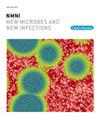Prevalence of Chlamydia trachomatis in eye specimens of patients suspected of having viral keratitis: a cross-sectional study
IF 5.4
Q2 INFECTIOUS DISEASES
引用次数: 0
Abstract
Background
Chlamydia trachomatis (C. trachomatis) is a major global health concern, recognized among the leading bacterial causes of sexually transmitted infections and implicated in ocular diseases. Its association with chronic follicular conjunctivitis and severe papillary inflammation underscores the importance of accurate identification in diagnosing trachoma. This study evaluated the prevalence of C. trachomatis in patients suspected to viral keratitis referred to the lab and comparing four different eye specimen types.
Methods
This cross-sectional study (2020–2022) involved 161 suspected to viral keratitis patients referred to thet lab and checked for viral and bacterial infections (49.1 % female, 50.9 % male) at Tehran University's Clinical Virology Research Center. Tear fluid, corneal epithelium, and aqueous/vitreous humor samples were analyzed using the Qiagen Mini Blood Kit for DNA extraction and Multiplex Real-Time PCR with the Fast-track diagnostics/SIEMENS eye kit. C. trachomatis was detected in 14 patients (8.7 %), who showed clinical features such as follicular conjunctivitis, corneal neovascularization, epithelial erosions, and conjunctival scarring. Details on pathology, disease course, treatments, and outcomes are provided in.
Conclusions
This study highlights the prevalence of C. trachomatis in suspected keratitis cases, offering a comparative view across different eye specimen types. Accurate detection using molecular assays supports timely intervention and targeted treatment, improving diagnostic precision and patient outcomes.
怀疑患有病毒性角膜炎的患者眼标本中沙眼衣原体的流行:一项横断面研究
沙眼衣原体(C.沙眼)是一个主要的全球健康问题,被认为是性传播感染的主要细菌原因之一,并与眼部疾病有关。它与慢性滤泡性结膜炎和严重乳头状炎的关联强调了准确诊断沙眼的重要性。本研究评估了实验室疑似病毒性角膜炎患者中沙眼原体的患病率,并比较了四种不同的眼部标本类型。方法本横断面研究(2020-2022)纳入了德黑兰大学临床病毒学研究中心的161例疑似病毒性角膜炎患者,并检查了病毒和细菌感染(49.1%为女性,50.9%为男性)。泪液、角膜上皮和水样/玻璃体样本使用Qiagen Mini Blood Kit进行DNA提取和multi - plex Real-Time PCR,使用Fast-track诊断/SIEMENS眼科试剂盒。14例(8.7%)患者检出沙眼原体,临床表现为滤泡性结膜炎、角膜新生血管、上皮糜烂、结膜瘢痕等。详细的病理,病程,治疗和结果提供在。结论本研究强调了疑似角膜炎病例中沙眼原体的患病率,并提供了不同眼部标本类型的比较观点。使用分子测定法进行准确检测,有助于及时干预和靶向治疗,提高诊断精度和患者预后。
本文章由计算机程序翻译,如有差异,请以英文原文为准。
求助全文
约1分钟内获得全文
求助全文
来源期刊

New Microbes and New Infections
Medicine-Infectious Diseases
CiteScore
10.00
自引率
2.50%
发文量
91
审稿时长
114 days
 求助内容:
求助内容: 应助结果提醒方式:
应助结果提醒方式:


